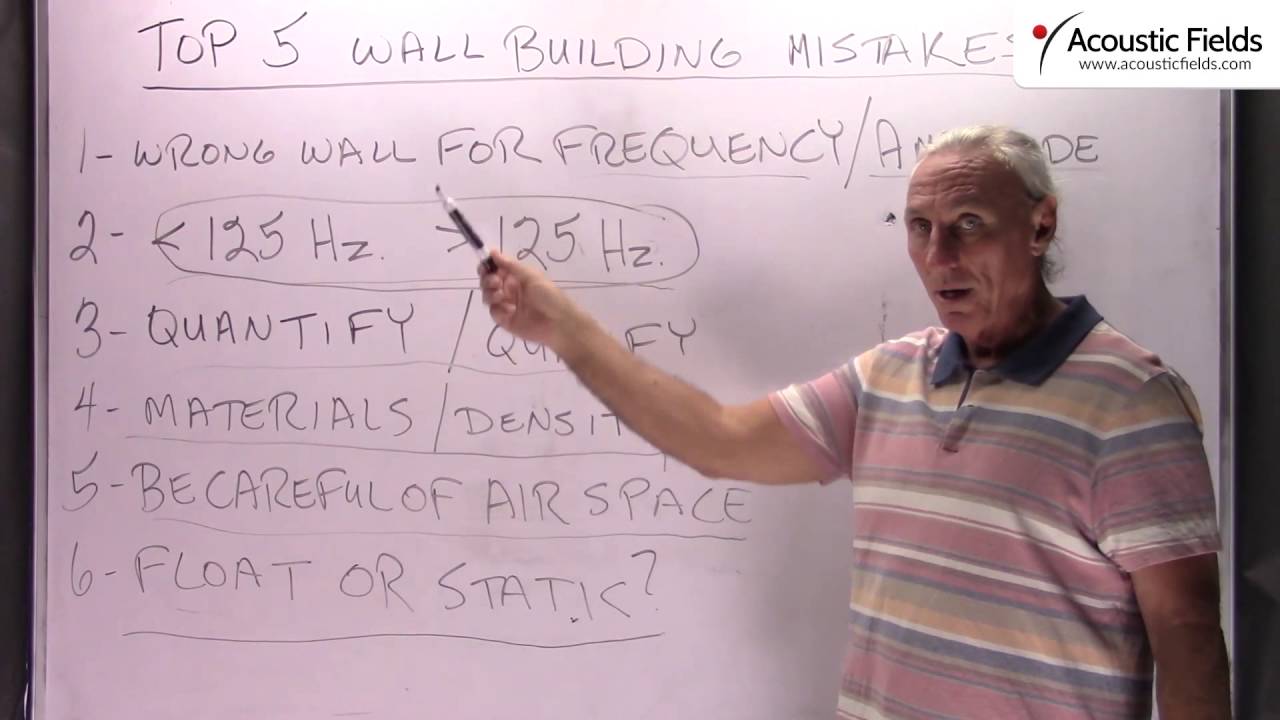Today we’re going to talk about the top 5 wall building mistakes that I see all the time. The first one is the wrong wall for the wrong job, I suppose we could say. Each wall that you build when you’re dealing with noise you have to take frequency and amplitude into consideration. If you don’t know what frequency the noise is at and you don’t know how strong it is, you have no idea about what wall to build.
So you have to quantify. You have to do some measurements. It’s not that hard, we go through that on other videos. It’s not that hard, some simple iPhone applications and you get a really good handle on what’s going on in terms of frequency and amplitude.
What’s the break point that we need to consider for frequency and amplitude? Below 125 and above 125 because the barrier technology once we do some measurements, for below 125 and above 125, completely different. A lot of these wall construction methods that you see in the literature, this double dry wall, green glue airspace, waste of space, much easier ways to achieve the same or higher STC values.
Also, a lot of mistakes I see is in the materials that you use, okay? You have to remember that everything you put in that wall, everything contributes to the sound quality in the music room. So if you’re going to have a concrete wall on the outside and you’re going to frame it on the inside for the treatment side, so the concrete is the noise or the barrier and then the treatment is the framing on the inside then you have a nice balance between flexibility and rigidity. There has to be a balance between the way the structure moves and the way it doesn’t move. So there has to be a balance there. Having just concrete to black noise below a 125 cycles is an effective barrier technology but it’s a horrible treatment technology. You wouldn’t play your music in a concrete room.
So you have to be cognizant of all the things that you’re doing about all the materials you’re using in the wall, the density of the wall, what frequencies we’re after, the magnitude, the strength of them, all that has to be taken into consideration.
There’s another thing I see a lot, be careful of airspace. People are building double walls with 6 inches, 8 inches, 12 inches of airspace. My gosh, that’s a lot of wasted space. A 2 by 6, you know, 6 inches, another 2 by 6, 6 inches and 6 inches of airspace, you have a foot and a half. And you haven’t even gotten to the treatment side of it yet.
And here’s another mistake I see all the time. Do I float my floors? Do I float my walls? Well, that all depends on the noise that we’re trying to isolate from. It’s not an opinion. You know, is it a good idea? Well, tell me what our problems are, tell me what the frequency and the amplitude of the problems are and then I’ll tell you if you need to float or just do static construction method. So floating ain’t cheap. So you want to make sure you’re floating because you got the problem that floating addresses. So there’s a correlation between frequency and floating.
So all of these issues, the wrong wall for the frequency and amplitude, they don’t take into consideration what their problems are before they build the wall and one size does not fit all when it comes to barrier technology. They don’t quantify, they don’t qualify, okay? You have to use the right materials that have the right density and composition.
Remember, you have to have to have the flexibility-rigidity ratio. You don’t have two structures, the shell and the treatment, both rigid. You know, one has to be flexible, one has to be rigid and obviously we prefer that the treatment side inside the room, we have the shell and then obviously the treatment is inside the room on this side, shells on the outside. So our treatment’s on the inside. There has to be a nice balance there.
Stay away from drywall. I can’t harp on this enough, there’s way better materials to get better sound on the inside of the room. And they’re not any more expensive. In fact, they’re much more cost-effective in the long run and much nicer to look at and much more conducive to higher quality sound. So floating or static construction, tell me what your problem is. Tell me how strong it is and I’ll tell you if you need to be float or static.








Hi Dennis! I just signed up for your informational’s and will be soaking it all in. Thanks so much for the expertise. I am going to be building a room in my basement, budgeted over time, as the $”s roll in, I hope its cool to pick your brain on shapes n stuff! I will be doing all the work myself and happy to send pics as it forms. Thanks again!!
Dave
Hi Dave, Fill out the information in this link: https://www.acousticfields.com/free-room-analysis/ Lets take a look at your room issues.